Page 1127 - Veterinary Toxicology, Basic and Clinical Principles, 3rd Edition
P. 1127
Zearalenone Chapter | 76 1059
VetBooks.ir days of age up to 145 or 312 days of age. Feeding up to are Zearalenone can affect ewe reproduction when ewes
mating.
mycotoxin
to
prior
the
exposed
to
9 mg zearalenone/kg feed to the boars did not affect
Zearalenone, administered orally at concentrations greater
libido, but boars fed the highest dose of zearalenone pro-
duced lower total and gel-free volumes of semen with than 3 mg/animal/day, given to ewes prior to mating
lower total motile sperm. Zearalenone does not appear to depressed ovulation rates and reduced lambing percen-
affect mature boars. No adverse effects in reproductive tages (Smith et al., 1990). Ewes administered a similar
parameters, including testicular size, libido, sperm motil- range of oral doses of zearalenone (0, 1.5, 3, 6, 12, and
ity and morphology, plasma testosterone and 17β-estradiol 24 mg/ewe/day) for 10 days, starting 5 days after mating,
concentrations, were reported in mature Yorkshire boars showed no effect of zearalenone exposure after mating on
fed increasing concentrations of purified zearalenone at 0, pregnancy rate or embryonic loss. Breeding rams fed a
2, 20, and 200 mg/kg ration for 8 weeks (Ruhr et al., diet containing 12 mg zearalenone/kg feed for 8 weeks
1983). had no significant adverse effects on semen volume, con-
The European Union (2006) guidance values for zear- centration, motility, or morphology during the trial and
alenone in feedstuff (with a moisture content of 12%) for for 6 weeks after zearalenone feeding was ceased (Milano
piglets and gilts is 0.1 mg/kg or ppm, for sows and fatten- et al., 1991).
ing pigs is 0.25 mg/kg, and for calves, dairy cattle, sheep,
and goats is 0.5 mg/kg.
Equine
Gimeno and Quintanilla (1983) reported estrogenic signs
Ruminants of edematous vulvas, prolapsed vaginas, oversized uter-
uses, and internal hemorrhage in mares and severe flac-
Several case reports have associated dairy herd health pro- cidity of genitals in two male horses fed corn screenings
blems and zearalenone in moldy feed. Young dairy heifers, for 30 days in a field exposure. All sick animals collapsed
6 14 months of age, developed slight enlargement of at with respiratory paralysis and sudden blindness, and died
least one mammary gland quarter while fed moldy corn in quickly. Analysis for zearalenone in the feed detected
aration(Bloomquist et al., 1982). Following a change in 2 3 mg zearalenone/kg diet. While the authors tested for
the ration, the heifers returned to normal 7 weeks later. a variety of mycotoxins by thin-layer chromatography,
Zearalenone contamination of the moldy ration was fumonisins in the corn screenings were not determined
detected by thin-layer chromatography. Roine et al. (1971) because they had not yet been recognized as mycotoxins
reported turbid discharge from the vulva, obvious estrous and a cause of death in horses. Fumonisins would have to
behavior lasting for 1 2 weeks, and infertility in dairy be considered as a primary cause of some of the adverse
cows and heifers. Strains of F. graminearum and F. cul- effects, particularly blindness and death, in these horses.
morum were isolated from the feed that caused an increase In a study of six cycling trotter mares, Juha ´sz et al.
in uterine weight in rats and were capable of producing (2001) determined that daily oral administration of 7 mg
between 3 and 9.5 mg zearalenone/kg feed. Va ´nyi et al. purified zearalenone starting 10 days after ovulation until
(1974) reported a drop in milk production, feed intake, and the subsequent ovulation had no adverse effect on repro-
swelling of the vulva in dairy cows exposed to varying duction. Zearalenone had no effect on the length of the
concentrations of zearalenone, ranging from 5 to 75 mg interovulatory intervals, luteal and follicular phases of
zearalenone/kg feed. In an experimental study, 18 cycling the ovary, and did not significantly affect uterine edema.
heifers were dosed with 0 or 250 mg of purified zearale- The authors noted that zearalenone exposure started 10
none daily through one nonbreeding estrous cycle and the days after ovulation and the exposure period to zearale-
next two consecutive estrous cycles during which the none was short in this study. The dose of purified zearale-
heifers were bred (Weaver et al., 1986a). The authors cal- none represented a natural contamination of feed of about
culated that treated heifers were given an average of 1 mg zearalenone/kg feed and ranged between 0.013 and
250 mg zearalenone/364 kg body wt/day or 0.69 mg zeara- 0.010 mg zearalenone/kg body wt/day for approximately
lenone/kg body wt/day. The control and treated heifers had 8 10 days.
conception rates of 87% and 62%, respectively, at a statis-
tical probability of P 5 .065. Eighteen dairy cows (three Poultry
cows per group) dosed orally with 0, 31.25, 62.5, 125, 250,
and 500 mg of purified zearalenone daily for two consecu- Growing female White Leghorn chickens dosed once
tive estrous cycles had no changes in serum progesterone orally with 15 g zearalenone/kg body wt showed no
concentration, erythrocyte and leukocyte blood counts, adverse effects in reproductive tissues (Chi et al., 1980).
packed cell volume, estrous cycle length, clinical health, or In a second experiment, chickens dosed orally or intra-
sexual behavior (Weaver et al., 1986b). muscularly with increasing concentrations of zearalenone

